Something has always puzzled me in my years working in the bird feeding industry: why don’t we offer more fresh fruit to birds in our yards? Oh sure, you can find mixes with dried fruit like banana chips and raisins. Heck you can even find mixes with heavy fruit flavoring…but why don’t we offer fresh fruit scraps to birds on tray feeders instead?
Many are familiar with offering orioles orange halves when they arrive in spring. The common wisdom is to also offer grape jelly and nectar. When the orioles arrive at my feeder, they definitely have a preference for the grape jelly to the orange–who doesn’t love to chow down on that high fructose corn syrup?
Here’s an image I took of a Plain Chachalaca in Harlingen, Texas coming in for grapefruit originally intended for orioles. All sorts of birds can be drawn in by fruit. Many backyard birding books recommend offering fresh fruit and a few bird feeding companies have even attempted to build feeders to offer fruit to birds but it’s not as popular as offering seed and suet. Is it a convenience issue?
One of my favorite things about Central America are the bird feeders. Above is a photo that I got with my Wingscapes BirdCam when I visited Canopy Lodge in Panama last year. That’s a Chestnut-headed Oropendola eating at a banana feeder. Banana was all that was offered and it brought in a huge array of birds.
Here’s a flock of Blue-gray Tanagers mixed in with one Broad-billed Euphonia. All sorts of birds from saltators to warblers flew in to eat the bananas. If the feeders were empty, the birds kept careful eye on the tray until a staff member piled them on (making sure to peal a bit of the banana to allow the birds access to the soft nourishment inside). Some of my happiest memories were sitting on the deck with a big ole’ cup of coffee and watching the parade of birds come in for the fruit. Okay, so you are not going to see oropendolas coming to fruit, but why not Scarlet Tanagers or Summer Tanagers? They are species that breed in the US and then spend the winter in Central and South America, eating what’s avialable–especially fruit.
This is a photo that my friend Larry Sirvio took in Belize. Check that out, it’s a Wood Thrush coming to a papaya feeder. Fruit is something that migratory birds could eat and worth trying in your yard in North America. It may take time to get birds used to the idea of coming to it regularly, but isn’t that true of any new bird food? Nyjer (aka Thistle) for goldfinches was introduced from Nigeria–someone had to experiment with that. Grape jelly for orioles was an experiment too. And think of all the people who offer mealworms to bluebirds. That was an experiment of training Eastern Bluebirds and Mountain Bluebirds to eat out of plastic dishes as bluebird montiors wanted to offer food to these birds that do not traditionally come to seed feeders. Where there is a will and some patience, there is a way.
Also, don’t be afraid to let the fruit get old and mushy. This will attract fruit flies and hummingbirds will come in for those too.
Anyone out there in the US had good luck with fruit already?

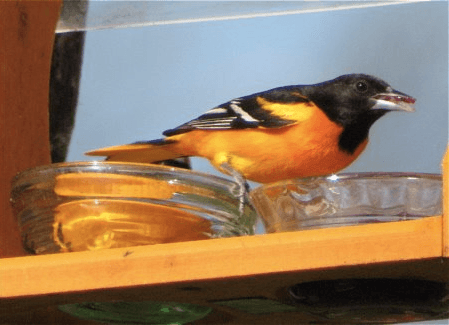
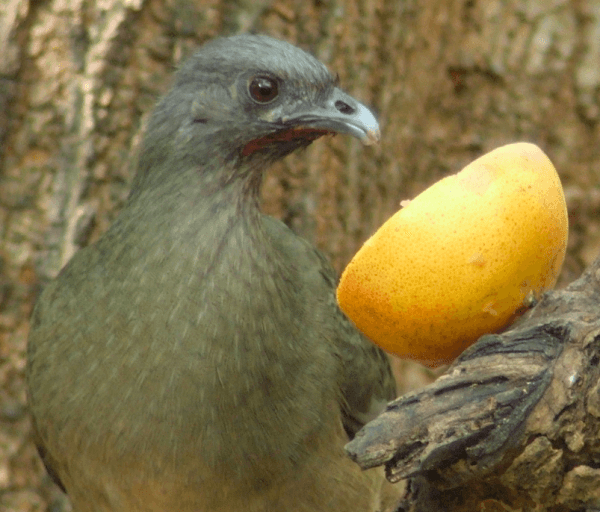
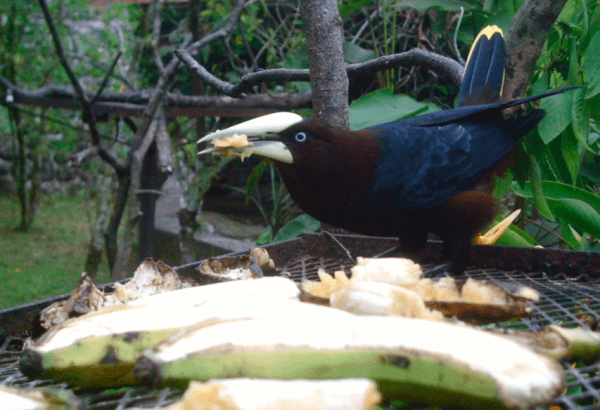
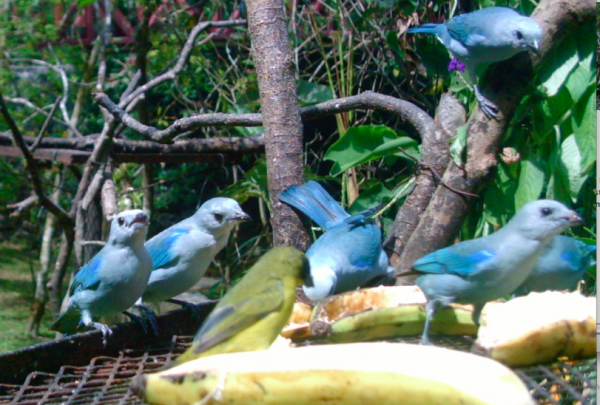
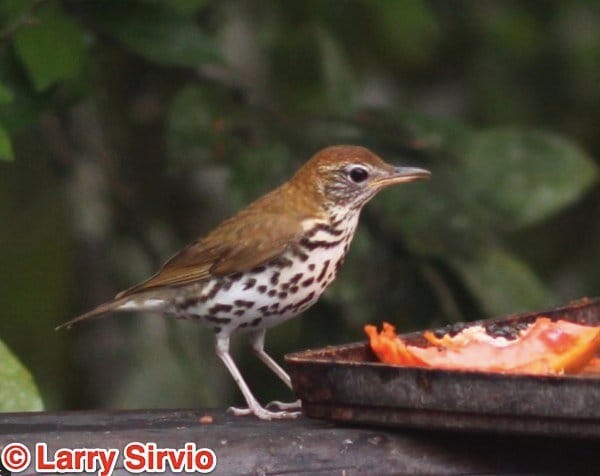










I’ve been experimenting with fruit in my backyard. After your blogging from central America I put out bananas, but had no takers. I’ve put out apples, no takers either. They do eat the old rotten apples still hanging on my apple tree however. Orange halves got lots of attention when I lived in Arizona, but little to none in Idaho and Utah. I have tried grape jelly in Idaho and it did get some birds feeding at it…but not the color Bullock’s Orioles or Western Tanagers that I was hoping for. I will be trying grape jelly again. I used put out broken open pomegranates in Arizona and birds were interested, but again, not in Idaho. Plan ol’ chuncky peanut butter works everywhere I have lived, along with suet and suet cakes. Half of the fun is just seeing what works and what doesn’t!
Great post, Sharon. Nothing makes me happier when discussing feeder birds to see crackers like Blue-gray Tanagers, oropendulas, and chachalacas!
My parents put out apples for the wintering thrushes and blackbirds. We used to do the same at my house for Tui and Kaka, but have been discouraged by the local conservation bodies because of cats.
http://10000birds.com/the-cracking-kaka-nestor-meridionalis.htm
Fruit is a great way to attract birds. Oranges for Orioles has always worked for me. There is a great Oriole feeder for anyone looking for a fruit feeder at http://www.birdhousecountry.com/product/BOF4-850
Yep, you gotta love those fruit feeding tables in Central and South America. I always wondered how well fruit feeders would work in the temperate zone. Most birds that show up at feeders in Costa Rica are residents but we also see a lot of orioles, Summer Tanagers, occasional Wood and Swainson’s Thrushes, and a fair number of Tennessee and Yellow Warblers.
It’s interesting to read some of the regional differences. I think if fruit is offered long enough, birds will figure it out.
As far as oriole feeders go, I prefer ones that are made of recycled plastic and come in orange. Orioles are attracted by color like hummingbirds. Recycled plastic is also easy to clean and lasts a long time.
This is something I have been curious about for as long as I can remember and is now turning into something that I would like to learn more about and begin to experiment with. Great post! I will keep checking back to follow the comments and appreciate any leads to more information that anyone out there may have.
Until my son acquired two cats I always put out fruit for our garden birds. The first to arrive were always the Go-away Birds (Grey Louries) who were the bully birds of the fruit table. After them came the Crested and Black-collared Barbets, the Dark-capped Bulbuls, the Cape White-eyes and the Southern Masked Weavers. I put out whatever fruit was available and in season. Apples, oranges, pawpaw, grapes, bananas, pineapple etc. and it certainly didn’t matter if the fruit was a bit too old for me to eat.
I have stopped feeding the birds because the cats (which have become much-loved members of the family) are far too adept at catching birds to give them an easy target.
It is interesting to hear from “birding is fun” that the fruit is not taken. I know from experience that birds are fussy about new things and will sometimes take a while to get into a new offering. When I moved into our new house I put out suet cakes for the birds to eat and had the first couple of attempts actually go off in the heat…..now I can’t keep up.
Bananas, apples and pawpaw and favourites here in South Africa and one day I was busy putting out some over ripe bananas when I discovered that the Bulbuls had eaten through the skin while the fruit was still in the bowl on the windowsill before I had a chance to get to the feeder.
The local grocer is normally happy to give away any over ripe fruit if you ask!
Hi! Thank you for your suggestion of experimenting with fruit! I am just now building a rewarding hobby of birdwatching, and I had read about offering fruit to attract more species to the feed station. The banana and papaya feeders are just large open trays? For the Mid-Atlantic states in the US, is that still the best way to offer apples/oranges? I put some sliced apple and orange wheels on a table near the hanging feeder. I am hoping for a big turnout! 🙂 A purple finch has visited the seed hopper twice (that I saw it). I want to attract more!
Here in west central Wyoming, we have many fruit-eating birds. I have planted a number of fruiting shrubs and small trees for the birds, and these are cleaned out every year. But my first efforts with artificial feeders were unsuccessful. No birds sampled the things on the feeder, although deer visited it nightly and ate up whatever I had put out during the day. I think the feeder was too close to my house. I moved the feeder this year into a cottonwood tree about 10 yards from the back door and tried again with jelly, apples and berries, as well as a variety of imported fruit. The tropical fruits– bananas, pineapple, citrus– received no attention, but temperate zone fruits were eaten immediately. The jelly was ignored for a long time until, suddenly, it became so popular I can hardly keep up with it.
I have been feeding apples and raisins and the robins just love them. we live in Ontario Canada and will be heading up north to our cottage and we have lots of orioles and grosbeaks can not wait to get up there and get our feeders up.